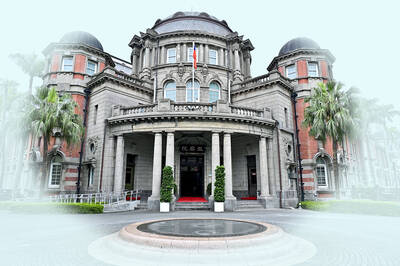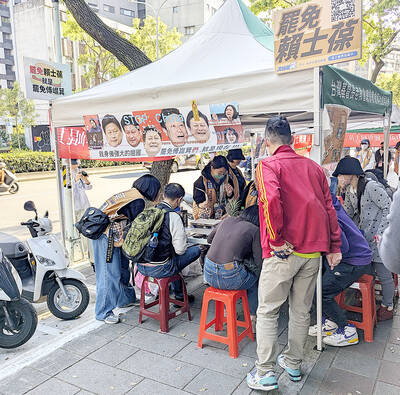Paris menswear displays ended Sunday with a flourish of flowing jackets, schoolboy bow-ties and profusely pleated pants as designers here refused to bow to the gloomy recession aesthetic that has cast a pall over other fashion capitals.
French label Lanvin put its money not on pinstripes or other business-friendly fabrics but sumptuous woolen knits that billowed or clung to the body in soft waves, creating a sensuous, romantic look.
Across town, Dior Homme was all hard lines and sharp angles.
Although the house sent out mostly black suits — a menswear staple in hard times — its innovative tailoring pushed the look forward.
British designer Paul Smith staged an energetic show that drew inspiration from the mischievous English schoolboy.
Throughout menswear week, which began on Thursday, other Paris designers also put flight and fancy above pure pocketbook concerns.
Highlights included John Galliano — who sent out models made up as Pan, the man-goat hybrid — and Givenchy, with its medieval sadomasochist look.
DIOR HOMME
Black suits that were anything but boring dominated at Dior Homme.
Asymmetrical cuts, strap and metalwork closures and heaps of pleats created an edgy, bold silhouette that played on volumes and contrast.
Designer Kris van Assche — who in 2007 replaced Hedi Slimane, the creator of the ultra-slim suit that was the house’s star piece — dared to go big, sending out billowy pants that bucked the overall trend in the Paris menswear shows toward slim trousers. A plethora of pleats fanning out from the low-slung waist band gave the pants an almost bubble cut through the hips and thighs.
Jackets dispensed with buttons, with one often asymmetrical flap closing over the another with hooks or graphic straps.
Turtlenecks, a recurring favorite at the Paris shows, were given a graphic twist. Cut in stiff white broadcloth, the generously draped necks stood straight up with contrasting black lining on the inside.
The entire show was black and white, and the closest thing to gray was a double-breasted overcoat in black and white bouclee.
French actress Beatrice Dalle praised the collection, which she called “really nice, really sober.”
“Although sobriety is not necessarily what I look for in a man,” Dalle said with a smile.
PAUL SMITH
The English schoolboy, with his tweed-heavy wardrobe and penchant for irreverent mixing and matching, had the run of the catwalk.
The collection was whimsical and fun even if Smith, whose flair for giving classics a twist has won him a worldwide following, didn’t stray far from his label’s hallmark style.
Tweed professor blazers were paired with slim plaid trousers and smart wool jackets were worn over cycling jerseys in bright primary colors. Flashes of hot pink lining peeked out from a blazer in oatmeal-colored houndstooth.
Bow-ties largely replaced conventional neckties, somehow managing to look dapper and not too out of place on the teenage models.
The same cannot be said for the show’s clunky plastic eyeglasses.
Those wearing the heavy, Clark Kent-style frames looked as if they were itching to rip off the nerd gear and re-emerge in tights and spandex.

The Taipei Times last week reported that the Control Yuan said it had been “left with no choice” but to ask the Constitutional Court to rule on the constitutionality of the central government budget, which left it without a budget. Lost in the outrage over the cuts to defense and to the Constitutional Court were the cuts to the Control Yuan, whose operating budget was slashed by 96 percent. It is unable even to pay its utility bills, and in the press conference it convened on the issue, said that its department directors were paying out of pocket for gasoline

On March 13 President William Lai (賴清德) gave a national security speech noting the 20th year since the passing of China’s Anti-Secession Law (反分裂國家法) in March 2005 that laid the legal groundwork for an invasion of Taiwan. That law, and other subsequent ones, are merely political theater created by the Chinese Communist Party (CCP) to have something to point to so they can claim “we have to do it, it is the law.” The president’s speech was somber and said: “By its actions, China already satisfies the definition of a ‘foreign hostile force’ as provided in the Anti-Infiltration Act, which unlike

Mirror mirror on the wall, what’s the fairest Disney live-action remake of them all? Wait, mirror. Hold on a second. Maybe choosing from the likes of Alice in Wonderland (2010), Mulan (2020) and The Lion King (2019) isn’t such a good idea. Mirror, on second thought, what’s on Netflix? Even the most devoted fans would have to acknowledge that these have not been the most illustrious illustrations of Disney magic. At their best (Pete’s Dragon? Cinderella?) they breathe life into old classics that could use a little updating. At their worst, well, blue Will Smith. Given the rapacious rate of remakes in modern

President William Lai’s (賴清德) March 13 national security speech marked a turning point. He signaled that the government was finally getting serious about a whole-of-society approach to defending the nation. The presidential office summarized his speech succinctly: “President Lai introduced 17 major strategies to respond to five major national security and united front threats Taiwan now faces: China’s threat to national sovereignty, its threats from infiltration and espionage activities targeting Taiwan’s military, its threats aimed at obscuring the national identity of the people of Taiwan, its threats from united front infiltration into Taiwanese society through cross-strait exchanges, and its threats from